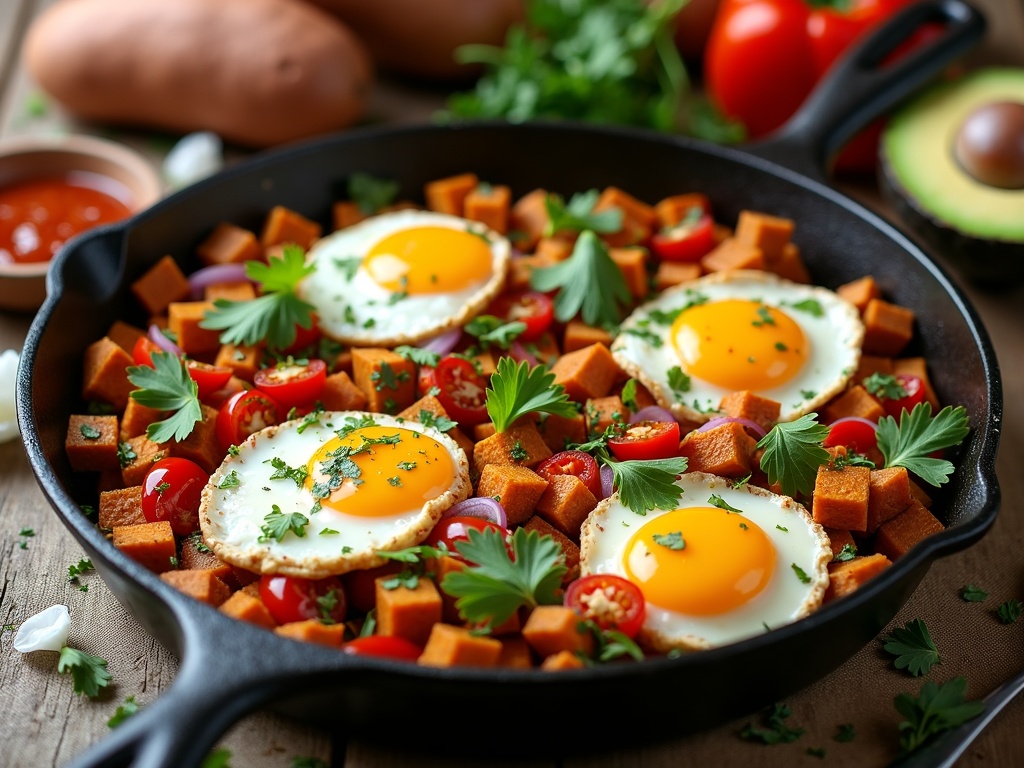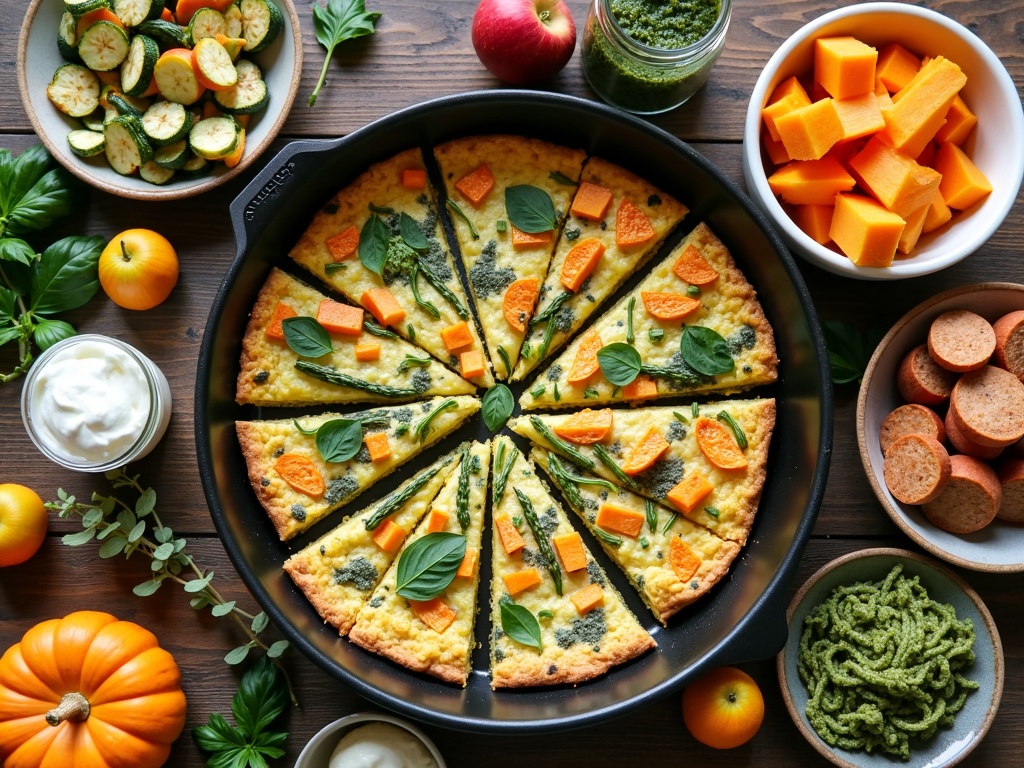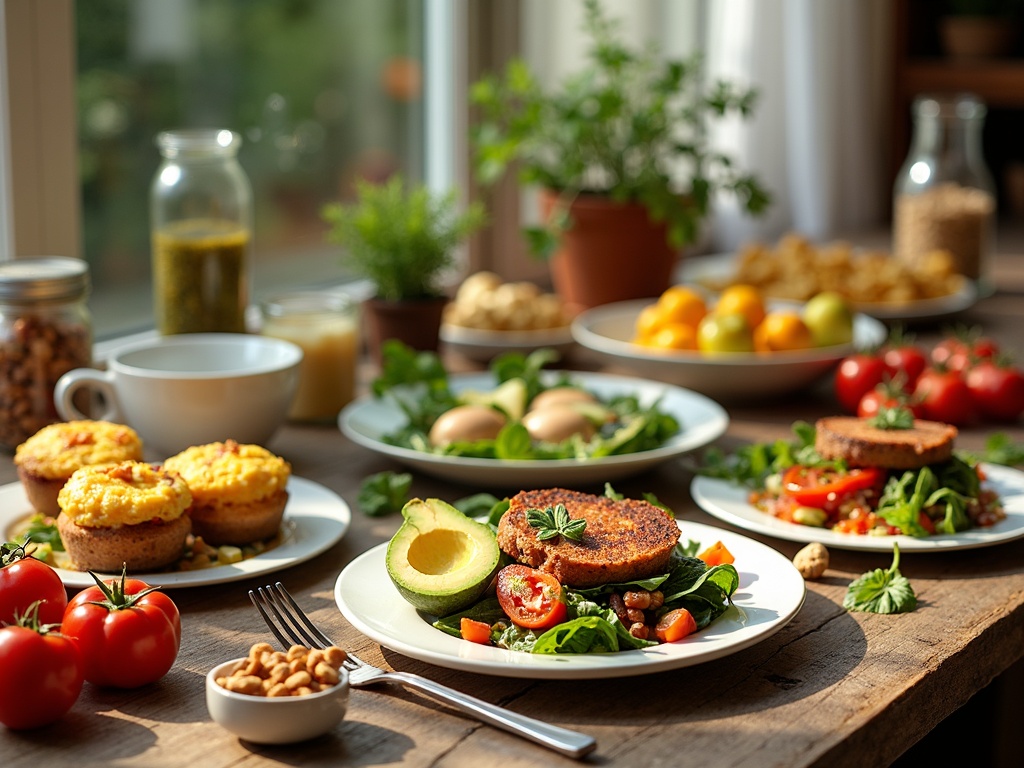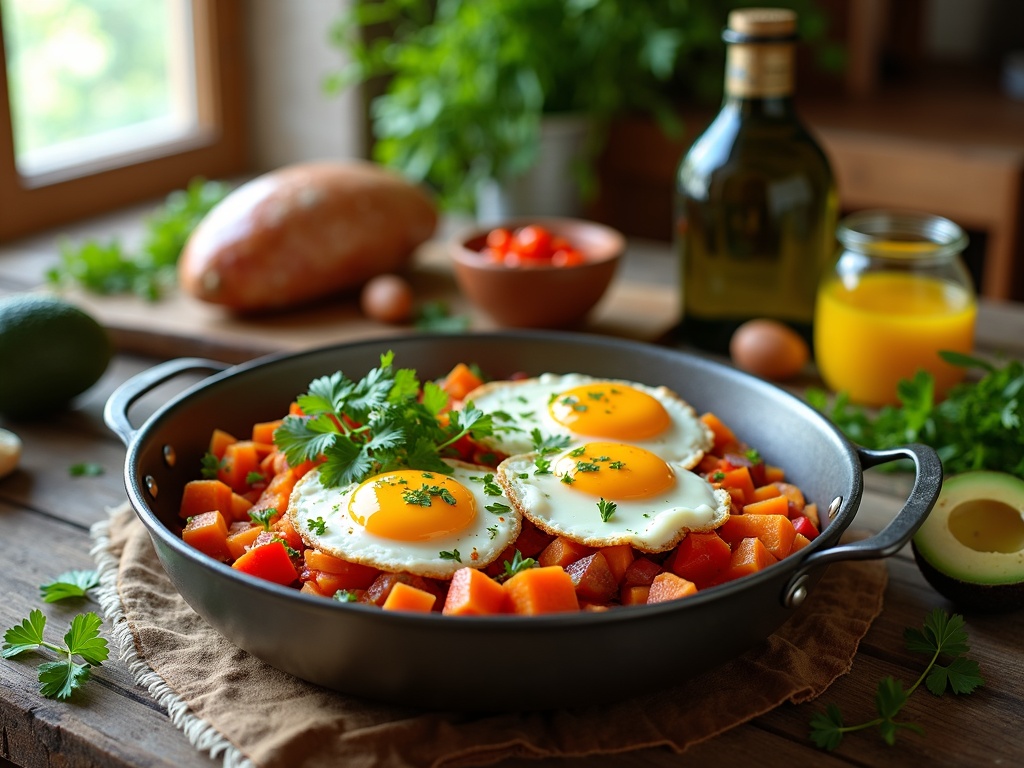The Whole 30 breakfast approach centers on nutritious, balanced meals built around proteins, healthy fats, and complex carbohydrates without processed ingredients. A versatile breakfast hash combining sweet potatoes, eggs, and colorful vegetables gives you a satisfying start that delivers sustained energy throughout your morning without complex preparation.
Find In This Article
Key Takeaways
- Sweet potatoes serve as an excellent base for Whole 30 breakfast hashes, providing complex carbohydrates that can be prepared in advance to save morning time.
- Incorporating protein variety (eggs, compliant sausage, leftover meats) helps prevent meal fatigue during the 30-day program.
- Meal prepping components like diced vegetables, pre-cooked proteins, and roasted sweet potatoes streamlines morning preparation.
- Adding healthy fats such as avocado slices or olive oil ensures breakfasts provide lasting satiety and balanced nutrition.
- Creative variations using seasonal vegetables, different cooking techniques, and compliant seasonings keep breakfast interesting throughout the program.
Quick and Easy Whole 30 Breakfast Hash
Starting your morning with a nutritious Whole 30 breakfast doesn’t have to be complicated or time-consuming. I’ve perfected a breakfast hash recipe that delivers a complete meal in just 20-30 minutes while keeping you energized and satisfied throughout your day.
Essential Ingredients for a Satisfying Hash
The beauty of a Whole 30 breakfast hash lies in its versatility and nutrient density. My go-to base includes sweet potatoes as the hearty foundation, eggs for protein, and plenty of colorful vegetables for vitamins and minerals. You can customize with compliant proteins like chicken, beef, or turkey to add even more staying power.
These ingredients work together to create a balanced meal that supports the benefits many Whole 30 participants experience. According to program data, over 1 million Whole 30 participants report improved digestion and increased energy levels when following the program guidelines.
For those looking for variety in your morning routine, you might also enjoy exploring paleo breakfast options which share many similarities with Whole 30-compliant meals.
Perfect Hash Preparation Method
I’ve found that creating the perfect hash comes down to proper technique and timing. Here’s my step-by-step method:
- Dice sweet potatoes into small, uniform cubes (about ½-inch) for faster cooking.
- Heat a large skillet over medium-high heat with 1-2 tablespoons of compliant cooking fat (like olive oil or ghee).
- Add sweet potatoes to the hot skillet, stirring occasionally until they begin to soften (about 5-7 minutes).
- Toss in diced onions, bell peppers, and any other firm vegetables, cooking for another 3-4 minutes.
- If using pre-cooked protein, add it now to warm through.
- Create small wells in the hash mixture and crack eggs directly into them.
- Cover the skillet and cook until eggs reach your preferred doneness (about 3-5 minutes).
- Garnish with fresh herbs, compliant hot sauce, or avocado slices.
The key to success is maintaining proper heat throughout the cooking process—hot enough to create those delicious crispy edges on the sweet potatoes, but not so hot that anything burns before cooking through.
For busy mornings, I recommend meal prepping components in advance. Pre-cooking sweet potatoes and storing them in the refrigerator can cut your morning cooking time in half. Similarly, having pre-chopped vegetables and cooked proteins ready to go makes assembly lightning fast.
If you’re looking for more grain-free morning options, gluten-free breakfast recipes offer additional variety while maintaining your commitment to clean eating.
This breakfast hash provides the perfect balance of protein, healthy fats, and complex carbohydrates to fuel your day. I’ve found it especially helpful during the initial adjustment period of the Whole 30 program when your body is adapting to the absence of processed foods, sugar, and grains.
For those seeking other nutritious morning meal ideas, healthy breakfast meals can provide additional inspiration while maintaining your commitment to clean eating principles.

Essential Ingredients for Whole 30 Success
Starting the day with a nutritious healthy breakfast meal is key to Whole 30 success. I’ve found that stocking my kitchen with the right ingredients makes planning morning meals much easier and more enjoyable.
Core Ingredients to Keep On Hand
The foundation of a great Whole 30 breakfast begins with quality ingredients. I always try to choose organic, grass-fed options when my budget allows. These choices not only taste better but also provide more nutrients.
Eggs are absolutely essential—they’re versatile, protein-packed, and can be prepared in countless ways. I keep at least a dozen on hand at all times. Sweet potatoes are another staple that I use regularly for hash, breakfast bowls, or simply roasted as a side. They provide the complex carbs needed for sustained energy throughout the morning.
Leafy greens like spinach, kale, and arugula add vital nutrients to breakfast dishes and pair beautifully with eggs. I toss them into scrambles or use them as bases for breakfast bowls.
Healthy fats are crucial for feeling satisfied on Whole 30. I always have these options ready:
- Avocados for slicing onto plates or making compliant guacamole
- Coconut oil for cooking at higher temperatures
- Extra virgin olive oil for lower-heat cooking and drizzling
Fresh herbs and compliant salsa transform simple dishes into flavorful meals. Cilantro, basil, and chives are my favorites for adding bright notes to morning dishes without introducing any non-compliant ingredients.
For proteins beyond eggs, I rely on:
- Ground turkey for making homemade breakfast sausage
- Chicken breasts that I can dice and add to breakfast hash
- Compliant bacon (without added sugar or preservatives)
One critical aspect of paleo breakfast preparation is reading labels carefully. Many seemingly innocent products contain added sugars, dairy derivatives, or grains that aren’t allowed on Whole 30. I’ve been surprised by hidden ingredients in items like dried fruit, broths, and even certain spice mixes.
When planning my gluten-free breakfast options, I look for whole ingredients that can be combined in different ways throughout the week. This approach helps maintain variety while staying true to the program guidelines. With these essential ingredients on hand, creating satisfying best healthy breakfast options becomes second nature.
Creative Recipe Variations to Keep It Interesting
The breakfast routine on Whole 30 doesn’t have to become monotonous. I’ve discovered numerous ways to add excitement to morning meals while still adhering to program guidelines. With a few clever substitutions and additions, your Whole 30 breakfasts can remain both compliant and crave-worthy.
Inventive Ingredient Swaps
Sweet potatoes often become a breakfast staple during Whole 30, but they’re not the only starchy vegetable that works well in morning recipes. I’ve found that butternut squash makes an excellent substitute, offering a slightly sweeter profile that pairs beautifully with savory eggs and compliant breakfast meats. Its texture holds up well when diced and roasted as a hash base.
Zucchini presents another fantastic alternative. Spiralized zucchini creates a light “noodle” base for breakfast bowls, or shredded zucchini can be pressed to remove moisture and formed into savory breakfast patties. These vegetables not only add variety but also provide different nutrient profiles to enhance your healthy breakfast meals.
The protein component doesn’t have to be predictable either. I rotate between eggs, compliant sausage, shredded chicken, and even leftover steak or salmon from dinner. This approach creates entirely different flavor profiles from day to day, keeping breakfast interesting throughout your thirty days.
Smart Prep Strategies
Meal preparation becomes your greatest ally during Whole 30. I’ve learned that making larger frittatas at the beginning of the week saves tremendous time and prevents reaching for non-compliant options when pressed for time.
A 9×13 baking dish can hold a frittata large enough for 6-8 servings. I simply line the bottom with pre-roasted vegetables, pour in whisked eggs mixed with compliant seasonings, and bake until set. These keep well in the refrigerator and taste delicious either cold or reheated.
For those seeking gluten-free breakfast options that align with Whole 30, these make-ahead frittatas offer perfect consistency without any gluten concerns.
Breakfast bowls assembled in advance work similarly well. I prepare various components—roasted vegetables, compliant protein, and fresh herbs—and store them separately. Each morning, I combine them in different proportions for a varied experience with minimal effort.
The seasonal approach adds another dimension to breakfast variety. Spring asparagus, summer zucchini, fall butternut squash, and winter kale create naturally rotating options for your best healthy breakfast choices throughout your Whole 30 journey.
Compliant sauces transform otherwise familiar ingredients into something new. Cashew cream made from soaked raw cashews blended with a touch of lemon juice and salt adds richness to vegetable hashes. Herb-based pestos (without cheese) made from basil, parsley, or cilantro drizzled over eggs create bright flavor profiles that keep breakfast exciting.
For those who miss the sweetness at breakfast, I’ve found that a small amount of compliant fruit adds natural sweetness without compromising your program. A few diced apples sautéed with cinnamon can transform a savory paleo breakfast hash into something reminiscent of a comfort food treat.
Texture variations also prevent breakfast boredom. Soft scrambled eggs one day, crispy-edged fried eggs the next, and silky poached eggs another day create distinct eating experiences even when other components remain similar.
Batch-cooking protein options like compliant chicken sausage patties allows for quick reheating while maintaining the no-carb breakfast approach that many find beneficial during Whole 30.
By implementing these creative variations, your Whole 30 breakfast experience transforms from potentially repetitive to genuinely enjoyable. The key lies in planning ahead, embracing seasonal ingredients, and understanding how different flavor components work together to create healthy breakfast foods that satisfy both nutritional needs and taste preferences.

Making the Perfect Hash
Hash has become my go-to Whole 30 breakfast solution. This versatile dish combines filling starches, nutrient-dense vegetables, and protein in one satisfying meal that keeps me energized all morning.
Building Your Base
I start by heating a tablespoon of coconut oil in a large cast-iron skillet over medium heat. The key to perfect hash is properly cooked sweet potatoes. I dice them into small, uniform cubes (about ½-inch) to ensure even cooking. Once the oil is hot, I add the sweet potatoes to the pan with a pinch of salt and let them sauté for 10-15 minutes, stirring occasionally. This develops a crispy exterior while maintaining a tender interior. For extra flavor, I sometimes add compliant seasonings like garlic powder, paprika, or dried herbs.
While the sweet potatoes cook, I prepare my vegetables separately. Bell peppers, onions, mushrooms, and spinach work wonderfully in a Whole 30 hash. I sauté them in a separate pan until just wilted – about 3-5 minutes – to prevent overcooking. This method preserves their texture and nutrients better than adding them directly to the potatoes.
When the sweet potatoes are almost done, I make room in the pan for eggs. I usually cook them sunny-side up, but scrambled or poached work equally well. The runny yolk creates a natural sauce that brings the hash together. For those who prefer a heartier hash, I’ll add compliant sausage or leftover healthy breakfast protein from previous meals.
Elevating Your Hash
To transform a basic hash into something special, I focus on these finishing touches:
- Fresh avocado slices add healthy fats and creaminess
- Chopped herbs like cilantro or parsley brighten the dish
- A dollop of compliant salsa adds acidity and flavor
- A sprinkle of nutritional yeast provides a cheesy flavor without dairy
- Toasted nuts or seeds create texture contrast
The beauty of a paleo breakfast hash is its adaptability. I can use whatever compliant ingredients I have on hand. Leftover roasted vegetables, cooked protein, or different starchy bases like butternut squash or plantains all work perfectly.
I’ve found hash particularly helpful during the first week of Whole 30 when adjusting to new breakfast options. It feels substantial and satisfying, unlike some no-carb breakfast options that might leave you hungry.
From prep to plate, the entire process takes 20-30 minutes, making it doable even on busy mornings. I often prep components ahead of time, dicing sweet potatoes and vegetables on meal prep day to streamline my morning routine.
For those new to Whole 30, hash provides a gluten-free breakfast option that doesn’t feel restrictive. The combination of protein, healthy fats, and complex carbohydrates creates a balanced meal that stabilizes blood sugar and provides lasting energy.
I’ve noticed that many best healthy breakfast options can feel limited on Whole 30, but hash breaks that pattern with endless variations. Seasonal vegetables, different proteins, and various cooking methods ensure I never get bored with this healthy breakfast food throughout my Whole 30 journey.
Program Benefits and Success Tips
The Whole 30 breakfast approach offers significant health advantages as part of this comprehensive reset program. I’ve seen firsthand how eliminating sugar, grains, dairy, and legumes for 30 days can transform not just mornings but overall wellbeing.
Many participants experience noticeable weight loss without counting calories or measuring portions. This happens naturally as your body adjusts to consuming nutrient-dense breakfast foods instead of processed items. The focus shifts from restriction to nourishment through whole, unprocessed ingredients.
Increased energy levels rank among the most commonly reported benefits. Initially, you might feel fatigued as your body adjusts, but this typically resolves within 5-7 days. I’ve found that participants who push through this adjustment period often experience sustained energy without the mid-morning crashes that accompany carb-heavy conventional breakfasts.
Optimizing Your Whole 30 Experience
Sugar withdrawal symptoms can be challenging during the first week. These might include headaches, irritability, and intense cravings. However, these symptoms usually subside within 7 days as your body adapts to utilizing fat for energy rather than quick-burning carbs and sugars.
The program’s emphasis on whole foods creates an optimal environment for health improvements. By focusing on quality protein sources and vegetables, you’re providing your body with essential nutrients without inflammatory triggers. This approach aligns closely with both paleo breakfast principles and low-carb morning meals, making it accessible for those familiar with these dietary styles.
For the best results during your Whole 30 journey, consider these practical tips:
- Prep breakfast components in advance to avoid morning decision fatigue
- Keep portable options available for busy mornings (egg muffins, compliant protein bars)
- Rotate between different protein sources (eggs, compliant sausage, chicken) to prevent food boredom
- Include healthy fats with each breakfast to promote satiety
- Experiment with gluten-free alternatives like sweet potato hash instead of traditional toast
The full 30-day commitment is crucial for experiencing maximum benefits. Many participants report that the most significant improvements occur during the final 10 days of the program. I’ve observed that those who complete the entire duration often discover food sensitivities they weren’t previously aware of during the reintroduction phase.
The program’s structure also helps establish sustainable healthy breakfast habits that extend beyond the initial 30 days. Many participants maintain elements of their Whole 30 breakfast routine long-term, particularly after experiencing improvements in digestion, skin clarity, and overall vitality.
Starting your day with compliant meals sets a positive tone that makes maintaining program guidelines easier throughout the day. The protein-forward nature of Whole 30 breakfasts provides lasting fullness, reducing the likelihood of non-compliant snacking or lunch choices due to hunger.
When approaching Whole 30 breakfasts, variety becomes your ally against program fatigue. Rather than viewing the guidelines as restrictive, I’ve found that embracing creativity with permitted ingredients leads to discovering new favorite morning meals that support both health goals and taste preferences.

Sources:
Whole30
“The Whole30: The 30-Day Guide to Total Health and Food Freedom” by Melissa Hartwig Urban
“Nutritional Impact of Whole Foods” – Nutritional Journal

